I need to measure temperature with an RTD between 0-300 C. I believe I have two options to make this work:
- A constant current source feeding the RTD
- A precision voltage reference and a resistor forming a voltage divider with the RTD.
It seems like I could use a precision voltage with an op-amp constant current source circuit to complete option 1. I could also use something like an LT3092.
This approach seems more complicated than option 2, where I could connect an ADR02 5V reference in line with a 5k 0.01% resistor to form a divider with the RTD.
I plan on using a 1k platinum 2 terminal RTD. Which is the better option, and why?
I've come up with this circuit after reading through the various suggestions.
Does it look like this will work? Should this reduce noise reasonably well?
The 10V clamp is for protection of the ADC. I think I also need an inline resistor on the output before the clamp, but not sure how to size it.

Best Answer
A current source ideally has infinite resistance. A resistor has positive resistance. There's a third choice- use current source with a large but negative output resistance which will linearize the RTD so that it has an 'S'-shaped residual error curve. Probably not worth it these days if you are going into the digital domain anyway.
Since an platinum RTD will only change from 1K to about 2.14K for 0°C~300°C you will lose about half your resolution if you use a simple resistor. A bridge can offset the voltage at 0°C and give you approximately full resolution. In any case your resistor should be connected to the same reference as your ADC so that reference voltage error cancels out and only the resistor values matter.
Something like this (you'd want to add other parts in a real implementation typically for EMI and so on).
simulate this circuit – Schematic created using CircuitLab
The output voltage is:
Vo/5V = R4/(R4+R1) - R3/(R2+R3) = R4/(R4+20K) - 1/21
So the output voltage would be 0 to 245.05mV for 0 to 300C.